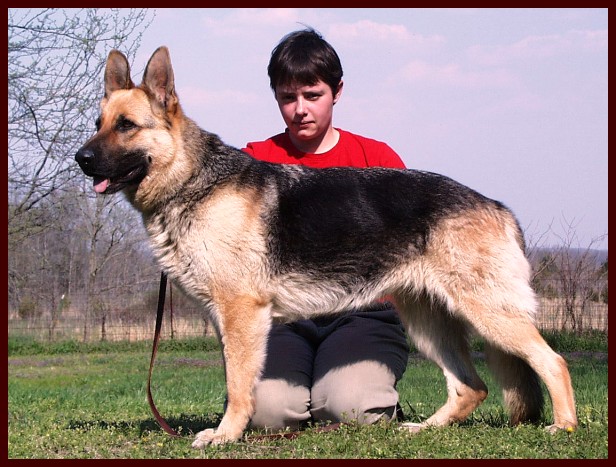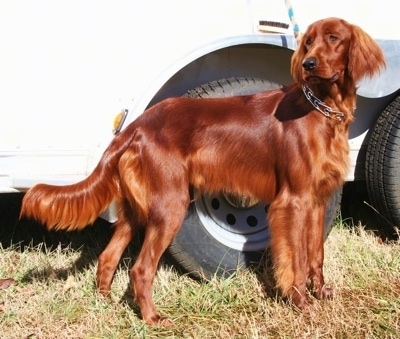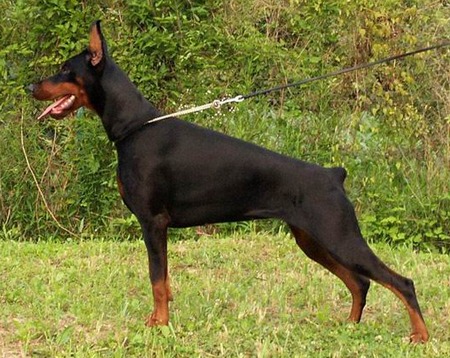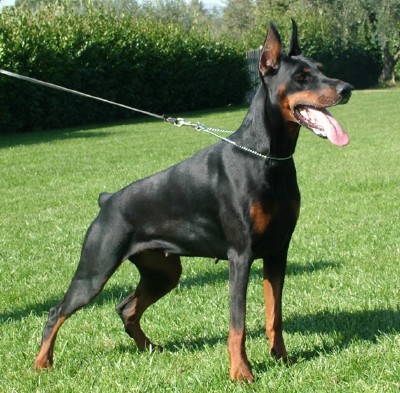
 This type of topline has now been bred into a very sloped, long and stretched back. There is nothing square about this topline or dog, and although some of these dogs have a lovely appearance, too much breeding of these backs can gradually produce some very sloped offspring. This is what has happened over the last 50 years or so to the German Shepherd Dog. It has now become standard for these dogs to appear this way unless of working lines. Most of this is partly due to show breeders, but some also to pet breeders. the GSD is still a very popular breed but is beginning to appear unsound to pet owners. Below is an image of a GSD with a very bad topline. Sadly, these dogs are being accepted as quality show dogs in certain countries. These dogs may be brilliant show dogs that fit certain standards, but they do not necessarily make good pets.
This type of topline has now been bred into a very sloped, long and stretched back. There is nothing square about this topline or dog, and although some of these dogs have a lovely appearance, too much breeding of these backs can gradually produce some very sloped offspring. This is what has happened over the last 50 years or so to the German Shepherd Dog. It has now become standard for these dogs to appear this way unless of working lines. Most of this is partly due to show breeders, but some also to pet breeders. the GSD is still a very popular breed but is beginning to appear unsound to pet owners. Below is an image of a GSD with a very bad topline. Sadly, these dogs are being accepted as quality show dogs in certain countries. These dogs may be brilliant show dogs that fit certain standards, but they do not necessarily make good pets.
 The GSD is not the only breed of dog with this issue. It has affected many other breeds, however, I will only mention one more of these. That breed which also has gradually lost topline quality is the show Irish Setter. The original Irish Setter, as shown below in this old painting, was a square hunting dog with little coat and a variety of head shapes. The basic shape is the same, but the dogs of today have changed dramatically in various bady features, such as toplines, coat and heads.
The GSD is not the only breed of dog with this issue. It has affected many other breeds, however, I will only mention one more of these. That breed which also has gradually lost topline quality is the show Irish Setter. The original Irish Setter, as shown below in this old painting, was a square hunting dog with little coat and a variety of head shapes. The basic shape is the same, but the dogs of today have changed dramatically in various bady features, such as toplines, coat and heads. The hunting/gundog Irish Setters are very sound and have a very good topline. Below is a photo of a working Irish Setter. Although this dog has a sound topline, it lacks much of the beautiful hair of the show Irish.
The hunting/gundog Irish Setters are very sound and have a very good topline. Below is a photo of a working Irish Setter. Although this dog has a sound topline, it lacks much of the beautiful hair of the show Irish. 
The Show Irish is very similar around the world, with the exception of a few different strains. The topline of the show Irish Setter is not the same as that of the working Irish, although it is not as extremely different as the GSD. Show Irish's tend to have a sloped topline and although these vary, the 'square' dogs are not usually prefferred. Below is a very sound, 'square' show Irish which resembles its forebearer somewhat. Although they are not considered more physically sound, the sloped Irish's are used most commonly as show dogs. These dogs, like the GSD, are good as show and pet dogs, but would be very impractical as working dogs because of their body shape. Below is an example of an Irish Setter with a sloped topline.

All images were found using google image search. Please note that these dogs are only examples and I consider them all beautiful specimins despite the issue in discussion.






